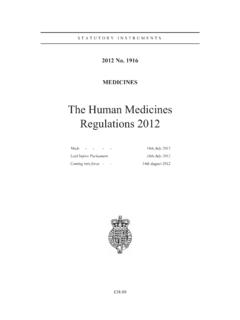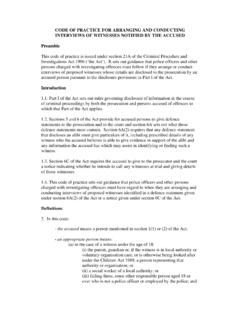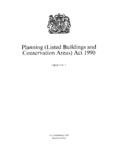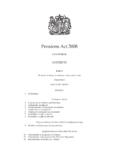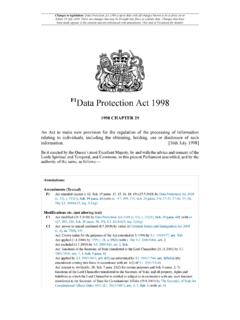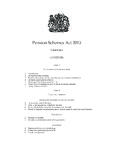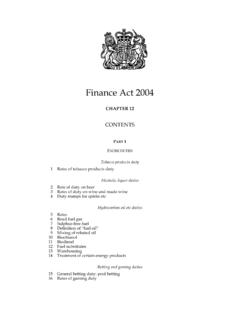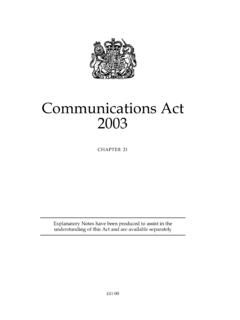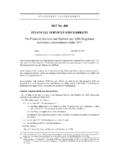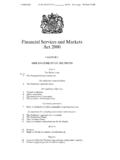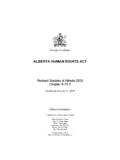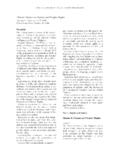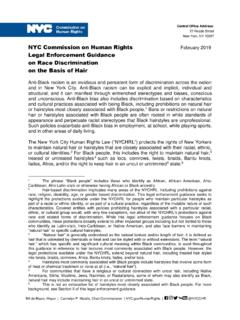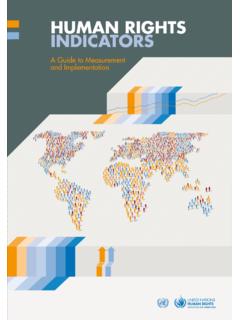Transcription of Human Rights Act 1998 - legislation.gov.uk
1 Changes to legislation: Human Rights Act 1998 is up to date with all changes known to be in force on orbefore 10 July 2018. There are changes that may be brought into force at a future date. Changes that havebeen made appear in the content and are referenced with annotations. (See end of Document for details) Human Rights Act 19981998 CHAPTER 42An Act to give further effect to Rights and freedoms guaranteed under the EuropeanConvention on Human Rights ; to make provision with respect to holders of certainjudicial offices who become judges of the European Court of Human Rights ; and forconnected purposes.[9th November 1998]Be it enacted by the Queen s most Excellent Majesty, by and with the advice and consent of theLords Spiritual and Temporal, and Commons, in this present Parliament assembled, and by theauthority of the same, as follows: Annotations:Extent InformationE1 For the extent of this Act outside the , see s. 22(6)(7)Modifications etc.
2 (not altering text)C1 Act: certain functions of the Secretary of State transferred to the Lord Chancellor ( ) by , arts. 3, 4, Sch. 1 para. 5C2 Act (except ss. 5, 10, 18, 19 and Sch. 4): Functions of the Lord Chancellor transferred to the Secretaryof State, and all property, Rights and liabilities to which the Lord Chancellor is entitled or subject toin connection with any such function transferred to the Secretary of State for Constitutional Affairs( ) by 2003/1887, art. 4, Sch. 1 Introduction1 The Convention Rights .(1)In this Act the Convention Rights means the Rights and fundamental freedoms setout in (a)Articles 2 to 12 and 14 of the Convention,(b)Articles 1 to 3 of the First Protocol, and(c)[F1 Article 1 of the Thirteenth Protocol],2 Human Rights Act 1998 (c. 42)Document Generated: 2018-07-10 Changes to legislation: Human Rights Act 1998 is up to date with all changes known to be in force on orbefore 10 July 2018. There are changes that may be brought into force at a future date.
3 Changes that havebeen made appear in the content and are referenced with annotations. (See end of Document for details)as read with Articles 16 to 18 of the Convention.(2)Those Articles are to have effect for the purposes of this Act subject to any designatedderogation or reservation (as to which see sections 14 and 15).(3)The Articles are set out in Schedule 1.(4)The [F2 Secretary of State] may by order make such amendments to this Act as heconsiders appropriate to reflect the effect, in relation to the United Kingdom, of aprotocol.(5)In subsection (4) protocol means a protocol to the Convention (a)which the United Kingdom has ratified; or(b)which the United Kingdom has signed with a view to ratification.(6)No amendment may be made by an order under subsection (4) so as to come into forcebefore the protocol concerned is in force in relation to the United :Amendments (Textual)F1 Words in s. 1(1)(c) substituted ( ) by The Human Rights Act 1998 (Amendment) Order 2004(S.)
4 I. 2004/1574), art. 2(1)F2 Words in s. 1 substituted ( ) by The Secretary of State for Constitutional Affairs Order 2003(S. I. 2003/1887), art. 9, Sch. 2 para. 10(1)2 Interpretation of Convention Rights .(1)A court or tribunal determining a question which has arisen in connection with aConvention right must take into account any (a)judgment, decision, declaration or advisory opinion of the European Court ofHuman Rights ,(b)opinion of the Commission given in a report adopted under Article 31 of theConvention,(c)decision of the Commission in connection with Article 26 or 27(2) of theConvention, or(d)decision of the Committee of Ministers taken under Article 46 of theConvention,whenever made or given, so far as, in the opinion of the court or tribunal, it is relevantto the proceedings in which that question has arisen.(2)Evidence of any judgment, decision, declaration or opinion of which account mayhave to be taken under this section is to be given in proceedings before any court ortribunal in such manner as may be provided by rules.
5 (3)In this section rules means rules of court or, in the case of proceedings before atribunal, rules made for the purposes of this section (a)by F3.. [F4the Lord Chancellor or] the Secretary of State, in relation to anyproceedings outside Scotland;(b)by the Secretary of State, in relation to proceedings in Scotland; or(c)by a Northern Ireland department, in relation to proceedings before a tribunalin Northern Ireland Human Rights Act 1998 (c. 42)Document Generated: 2018-07-103 Changes to legislation: Human Rights Act 1998 is up to date with all changes known to be in force on orbefore 10 July 2018. There are changes that may be brought into force at a future date. Changes that havebeen made appear in the content and are referenced with annotations. (See end of Document for details)(i)which deals with transferred matters; and(ii)for which no rules made under paragraph (a) are in :Amendments (Textual)F3 Words in s. 2(3)(a) repealed ( ) by The Secretary of State for Constitutional Affairs Order2003 (S.)
6 I. 2003/1887), art. 9, Sch. 2 para. 10(2)F4 Words in s. 2(3)(a) inserted ( ) by The Transfer of Functions (Lord Chancellor and Secretaryof State) Order 2005 ( 2005/3429), art. 8, Sch. para. 3 Modifications etc. (not altering text)C3S. 2(3)(a): functions of the Secretary of State to be exercisable concurrently with the Lord Chancellor( ) by The Transfer of Functions (Lord Chancellor and Secretary of State) Order 2005 ( ), art. 3(2) (with arts. 4, 5)Legislation3 Interpretation of legislation.(1)So far as it is possible to do so, primary legislation and subordinate legislation mustbe read and given effect in a way which is compatible with the Convention Rights .(2)This section (a)applies to primary legislation and subordinate legislation whenever enacted;(b)does not affect the validity, continuing operation or enforcement of anyincompatible primary legislation; and(c)does not affect the validity, continuing operation or enforcement of anyincompatible subordinate legislation if (disregarding any possibility ofrevocation) primary legislation prevents removal of the of incompatibility.
7 (1)Subsection (2) applies in any proceedings in which a court determines whether aprovision of primary legislation is compatible with a Convention right.(2)If the court is satisfied that the provision is incompatible with a Convention right, itmay make a declaration of that incompatibility.(3)Subsection (4) applies in any proceedings in which a court determines whether aprovision of subordinate legislation, made in the exercise of a power conferred byprimary legislation, is compatible with a Convention right.(4)If the court is satisfied (a)that the provision is incompatible with a Convention right, and(b)that (disregarding any possibility of revocation) the primary legislationconcerned prevents removal of the incompatibility,it may make a declaration of that incompatibility.(5)In this section court means [F5(a)the Supreme Court;]4 Human Rights Act 1998 (c. 42)Document Generated: 2018-07-10 Changes to legislation: Human Rights Act 1998 is up to date with all changes known to be in force on orbefore 10 July 2018.
8 There are changes that may be brought into force at a future date. Changes that havebeen made appear in the content and are referenced with annotations. (See end of Document for details)(b)the Judicial Committee of the Privy Council;(c)the [F6 Court Martial Appeal Court] ;(d)in Scotland, the High Court of Justiciary sitting otherwise than as a trial courtor the Court of Session;(e)in England and Wales or Northern Ireland, the High Court or the Court ofAppeal.[F7(f)the Court of Protection, in any matter being dealt with by the President of theFamily Division, the [F8 Chancellor of the High Court] or a puisne judge ofthe High Court.](6)A declaration under this section ( a declaration of incompatibility ) (a)does not affect the validity, continuing operation or enforcement of theprovision in respect of which it is given; and(b)is not binding on the parties to the proceedings in which it is :Amendments (Textual)F5S. 4(5)(a) substituted ( ) by Constitutional Reform Act 2005 (c.)
9 4), ss. 40, 148, Sch. 9 (2); 2009/1604, art. 2(d)F6 Words in s. 4(5)(c) substituted ( for certain purposes and otherwise) by ArmedForces Act 2006 (c. 52), ss. 378, 383, Sch. 16 para. 156; 2009/812, art. 3 (with transitionalprovisions in 2009/1059); 2009/1167, art. 4F7S. 4(5)(f) inserted ( ) by Mental Capacity Act 2005 (c. 9), ss. 67(1), 68(1)-(3), Sch. 6 (with ss. 27, 28, 29, 62); 2007/1897, art. 2(1)(c)(d)F8 Words in s. 4(5)(f) substituted ( ) by Crime and Courts Act 2013 (c. 22), s. 61(3), Sch. 14para. 5(5); 2013/2200, art. 3(g)5 Right of Crown to intervene.(1)Where a court is considering whether to make a declaration of incompatibility, theCrown is entitled to notice in accordance with rules of court.(2)In any case to which subsection (1) applies (a)a Minister of the Crown (or a person nominated by him),(b)a member of the Scottish Executive,(c)a Northern Ireland Minister,(d)a Northern Ireland department,is entitled, on giving notice in accordance with rules of court, to be joined as a partyto the proceedings.
10 (3)Notice under subsection (2) may be given at any time during the proceedings.(4)A person who has been made a party to criminal proceedings (other than in Scotland)as the result of a notice under subsection (2) may, with leave, appeal to the [F9 SupremeCourt] against any declaration of incompatibility made in the proceedings.(5)In subsection (4) criminal proceedings includes all proceedings before the [F10 CourtMartial Appeal Court]; andHuman Rights Act 1998 (c. 42)Document Generated: 2018-07-105 Changes to legislation: Human Rights Act 1998 is up to date with all changes known to be in force on orbefore 10 July 2018. There are changes that may be brought into force at a future date. Changes that havebeen made appear in the content and are referenced with annotations. (See end of Document for details) leave means leave granted by the court making the declaration ofincompatibility or by the [F11 Supreme Court]Annotations:Amendments (Textual)F9 Words in s.
